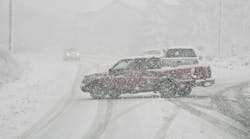Poor visibility, especially at night, is a serious driving hazard. According to the Motor Vehicle Lighting Council, poor visibility is cited as a factor in an estimated 2.8 million accidents, 23,000 fatal crashes and 2,300 pedestrian deaths every year in the United States. OSRAM SYLVANIA, the world leader in automotive lighting solutions, offers a variety of automotive headlights that provide better peripheral vision and viewing of the road ahead.
“Preparing your vehicle for winter is critical for safe driving throughout the season,” said Denise Champagne, marketing manager for OSRAM Sylvania. “It’s important to make sure headlights are a part of seasonal maintenance.”
For drivers of any age, follow these tips to help maintain safety and improve visibility on the road this winter:
- Winterize your vehicle – Change the engine lubricant to synthetic oil, change to winter wiper blades, flush your cooling system with fresh coolant/antifreeze, fill the washer fluid reservoir with de-icer washer fluid and carry an emergency safety kit.
- Drive with your lights on – If daytime visibility is limited, turn on your headlights to be seen by other drivers. When traveling in snowy weather, remember to brush off your taillights, turn signals and headlamps.
- Change headlights in pairs before they burn out – Most headlights dim up to 20 percent over time so evaluate yours every year for optimum performance. The end of daylight savings time is a perfect yearly reminder.
- Upgrade to high performance halogen lighting – Studies have shown that whiter, brighter halogen lighting can improve reaction time, increase nighttime visibility and provide better roadside viewing.
- Check headlight alignment – Misaligned headlights can be distracting and dangerous. Ask your auto service technician to align them for you.
- Clean headlight lenses regularly – Wash headlight lenses when you wash your windshield. You’ll see better at night and in poor weather conditions.
- Make sure all vehicle lights are working – Have a friend turn on your headlights and signal lights while you walk around the outside of your vehicle.
- Check your tire pressure regularly – Whether you park inside or outside, you will lose a pound of tire pressure for every 10 degrees of outside temperature change.
- Adjust your speed – By decreasing your speed, you allow yourself more time to respond in bad weather.
- Brake carefully – When roads are slippery, brake in a straight line before a curve in the road. Lift your foot from the brake before you steer into a corner. This allows you to steer and not slide through the corner. Don’t accelerate away from the corner until the steering wheel is again straight.
